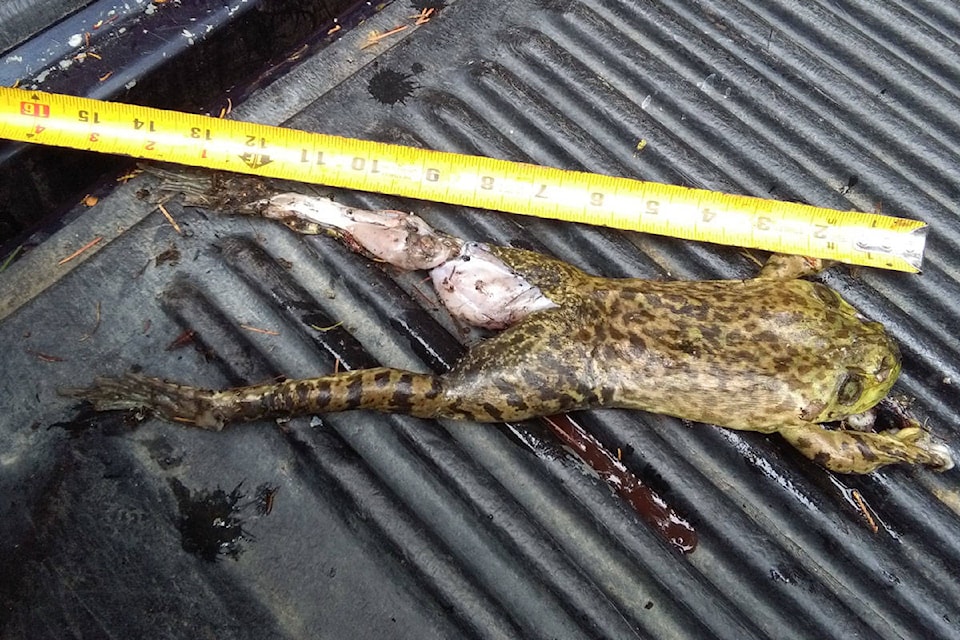A Metchosin resident came across a concerning creature this week.
Kevin Cordingley lives in the Happy Valley area and was driving along Glen Forest Way when he spotted a large American bullfrog on the road. It looked like it had been hit, according to Cordingley.
Cordingley found the frog was about 14 inches long with its legs stretched out.
“I’ve never seen one like that before,” Cordingley said. He went to the municipal hall in Metchosin and was told the District is already looking into the species invading the area. He noted that he noticed fewer living creatures in the creek in his backyard recently, and wondered if the disappearance was related to the appearance of American bullfrogs.
“I was troubled to hear they’ve invaded the Southern Island,” Cordingley said. “But we’ve been expecting it.”
Stan Orchard, president of BullfrogControl.com Inc. is a conservation biologist and amphibian and reptile specialist. He tries to find strategies and techniques to eradicate populations of the American bullfrog, a creature that is listed as one of the 100 worst alien invasive species in the world.
Orchard said Cordingley has a right to be concerned.
“It’s an ecological menace species,” Orchard said. “They proliferate very rapidly, every female is producing 20,000 or more eggs a year and they eat organisms above and below the water so their ecological footprint is huge.”
The first generation of bullfrogs are thought to be introduced to the Island in Saanich by two people who farmed for frog legs in their backyard. Another cause was a child releasing a bucket of large American bullfrog tadpoles into Beaver Lake.
“The frogs don’t stay where you put them, they take off to invade other lakes and ponds,” Orchard said.
Every year, Orchard and his team members work through the active bullfrog season to target areas where the species have been identified as an issue. The team heads out to shallow waters on inflatable boats, shining a spotlight on the water in the hopes of catching a reflection of the frog’s eyes.
While the frog is dazzled by the bright light, another team member uses what Orchard calls an ‘electro-frogger’ — a pole that generates an electrical field — to zap the frog. It is then scooped up and brought back to Orchard’s lab where it can be dissected and examined.
The American bullfrog’s population density can become very high rapidly, Orchard said, so they can out-compete other species for food and space.
“They will eat absolutely anything that can fit in their mouth,” Orchard said, noting he’s found their stomachs full of egg-bearing, female tree frogs and hatchling painted turtles that are consumed when they emerge from the nest.
The District of Metchosin has requested Orchard’s services to help deal with their own bullfrog problem.
Orchard said it seems as if the species has been released in a pond in Metchosin years ago and the population has been expanding every since. He said the District has come up with money for his team to go out a certain number of nights and target areas where the bullfrogs are. However, he said he is also focusing on keeping the American bullfrog out of the Victoria watershed.
In order to truly expand his reach into Metchosin and the Highlands, Orchard said he will require more manpower and funding. In the meantime, Orchard continues to come up with different techniques to eradicate populations of the invasive American bullfrog.
shalu.mehta@goldstreamgazette.com
